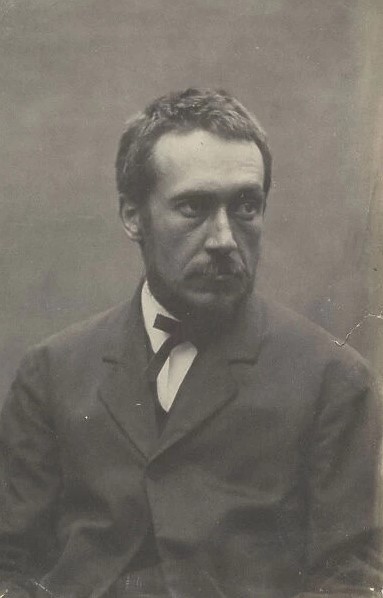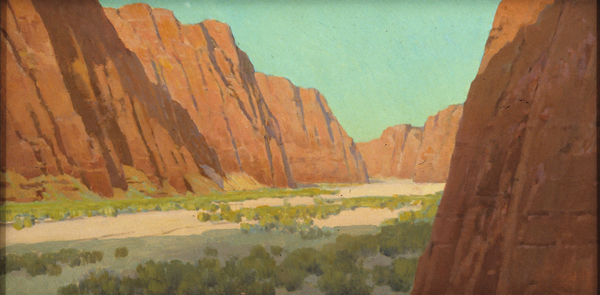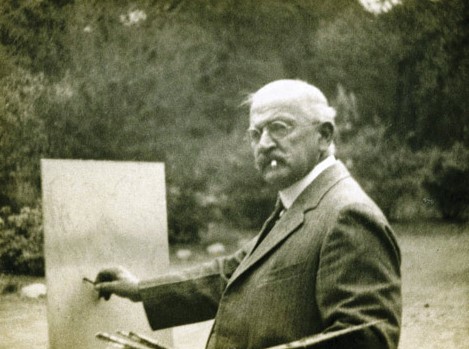
FEATURE Image: Fernand Harvey Lungren (1857-1932), The Café, 1882/84, oil on canvas. The Art Institute of Chicago. 9/2014.

The artist, born in Sweden, moved with his family to Toledo, Ohio, as a child. Lungren wanted to be an artist but his father objected, wanting him to be a mining engineer. For a brief time, in 1874, Lungren attended the University of Michigan at Ann Arbor to study his father’s preferred subject. But after two years—Lungren’s father still opposed to his son being an artist— saw the younger Lungren rebel and prevail. In 1876 Lungren was able to study under Thomas Eakins (1844-1916) at the Pennsylvania Academy in Philadelphia and had Robert Frederick Blum (1857-1903), Alfred Laurens Brennan (1853-1921) and Joseph Pennell (1857-1926) as fellow students.

In winter 1877 the 20-year-old Lungren moved to New York City. With his first illustration published in 1879, he worked as an illustrator for Scribner’s Monthly (renamed Century in 1881) as well as for Nicholas (a children’s magazine) and as a contributor until 1903. He later worked for Harper’s Bazaar, McClure’s and The Outlook. Lungren’s illustrations included portraits, and social and street scenes.

In June 1882 Lungren sailed to Paris via Antwerp with a group of artists. In an 18-month stay in Paris he studied informally for two months at the Académie Julian, and viewed the latest French Impressionist artworks. He found his artistic purpose in Paris in direct observation and spent the balance of his time studying Parisian street scenes in the manner of the “new painting.”




Lungren returned to New York City in 1883 and, soon afterwards, established a studio in Cincinnati, Ohio. Sponsored by the Santa Fe Railroad which wished to commission images of the Southwest to entice eastern tourists, Lungren made his first excursions west in the early 1890s. In 1892 he visited Santa Fe, New Mexico for the first time and, in the following years painted artworks inspired by his contact with American Indian culture and the desert landscape. This was the start of his lifelong association with American West and Southwest. In 1899 he showed these American desert works at the American Art Galleries in New York and afterwards at the Royal Academy in London and the Walker Art Gallery in Liverpool.

oil on canvas
18 3 /16 x 36″, c. 1903-1906. AD&A Museum, Santa Barbara, CA.
When Lungren was in London he made pictures of street life and met several artists, including James Abbott McNeill Whistler (1834-1903). In late 1900 Lungren traveled to Egypt with American pharmaceutical entrepreneur Henry Solomon Wellcome (1853-1936) and returned to New York via London in the next year. Lungren had married Henrietta Whipple in 1898 and they eventually moved to California in 1903, settling in Mission Canyon above Santa Barbara in 1906.


oil on canvas
25 1/4 x 45 in.; framed: 29 3/4 x 49 3/4 x 2 in. AD&A Museum
Lungren lived and work in California—including several notable trips to Death Valley starting in 1909 —until his death in 1932. After Lungren’s wife died in 1917, the artist helped found the Santa Barbara School of the Arts in 1920 and remained on its board until his death in 1932. He became a charter member of the Santa Barbara Art League and executed two works for dioramas at the Santa Barbara Museum of Natural History. Most of Lungren’s artwork, including hundreds of his paintings (some 300 works), were bestowed to Santa Barbara State Teachers College, which became the University of California, Santa Barbara, and are part of the University Art Museum

SOURCES:
J.A. Berger, Fernand Lungren: A Biography, Santa Barbara, 1936.
http://art-collections.museum.ucsb.edu/collections/show/44 – retrieved May 1, 2024.
https://collection.sina.cn/zhuanlan/2022-03-11/detail-imcwipih7897380.d.html – retrieved May 1, 2024.
https://www.artic.edu/articles/960/fernand-lungren-illuminated-in-the-cafe-and-the-city-of-lights – retrieved May 1, 2024.




